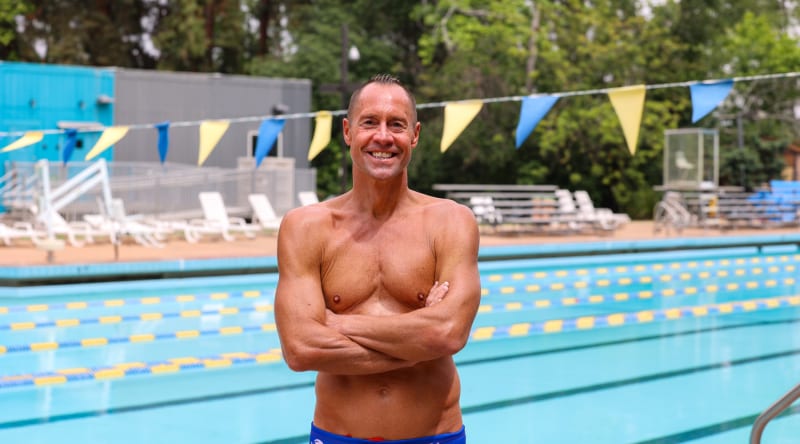

Bill May’s journey in synchronized swimming hasn’t been easy. Gender posed a significant barrier when he began at the age of 10. Despite the challenges, he persisted, breaking down barriers and emerging as a leading advocate for males in synchronized swimming. Most recently, Team USA unveiled its full 12-athlete lineup on Saturday.
Watch What’s Trending Now!
The 45-year-old swimmer, whose inclusion on the list was widely predicted, was surprisingly missing. Bill May did not make the U.S. squad for the 2024 Olympics in Paris, despite his revolutionary actions. However, May competed for the US in a team event at the Aquatic World Championships in Doha, Qatar, in February. This marked the country’s first Olympic qualification since 2008. May’s Olympic aspirations held some hope due to this accomplishment, but uncertainty still loomed over his path.
May’s tale is more than just an Olympic story. It’s a monument to his continuous struggle to secure a spot in the sport. Bill May began his journey with the Syracuse Synchro Cats and Oswego Lakettes in New York. He relocated to Santa Clara, California, in 1996 to train with the Santa Clara Aquamaids. Despite facing exclusion from numerous events, he persevered in his dedication. May claims, “I was pretty stubborn and determined to stay in the sport I loved.”
ADVERTISEMENT
Yet, he persisted anyway, driven by a profound affection for his discipline. “I still wanted to do it even if it meant I would never be allowed to compete in the Olympics,” May says. The examples offered by his swim group friends strengthened his commitment. Knowing that they would never be able to compete at the Olympics, these players never gave up on their training. “I took inspiration from friends on the swim team that continued to compete even though they would never make it to the Olympic level,” he noted.

ADVERTISEMENT
When he began participating internationally in duet competitions, his perseverance paid off as he won multiple golds. However, May was a spectator at the 2004 Summer Olympics in Athens due to gender restrictions in his sport. Instead, he appeared in the water-based Cirque du Soleil performance “O” in Las Vegas. Despite this setback, his passion for synchronized swimming never faltered, and he continued advocating for males to be allowed to participate in the sport. His efforts bore fruit when FINA permitted males to compete in mixed duet events at the World Championships in Kazan, Russia, in 2015. May’s actions paved the way for men swimmers in synchronized swimming, and he himself achieved significant success by winning gold and silver medals at the competition.
ADVERTISEMENT
Bill May’s route filled with odds
In December 2022, World Aquatics made history by announcing a rule change that will allow men to compete in artistic swimming at the Olympics. With this ruling, the eight-athlete group event will now include up to two male swimmers from each National Olympic Committee (NOC), marking a significant change for the sport formerly known as synchronized swimming. Although males have been able to compete in the World Aquatics Championships since 2015, before this historic development, artistic swimming at the Olympic Games had only been open to female competitors. The inclusion of male athletes at the Olympic level has brought much hope to the world of artistic swimming.
With the excitement for the Olympics in Paris growing, May ended up being the sole man competing in artistic swimming. The bad news is that Team USA has opted not to send any men to the 2024 Summer Olympics in artistic swimming. With this move, America becomes the last nation to reveal its team, confirming that there won’t be any male athletes competing in the event at the next Games.
ADVERTISEMENT
However, May’s journey has been difficult, particularly since Italy’s top male athlete, Giorgio Minisini, was ruled out from the country’s April Olympic preparations. According to Adam Andrasko, chief executive of USA Artistic Swimming, the call to drop out Bill May was made to send the best squad possible. “Unfortunately, the rules of artistic swimming only allow for eight athletes to swim all three routines,” Andrasko clarified.“We will continue to celebrate Bill and support male participation across the sport while also celebrating the story of these eight incredible women.”
Top Stories
NFL Makes Final Punishment Decision on Shedeur Sanders Incident in Week 17

Jerry Jones Finally Acknowledges the Dak Prescott Gamble Hasn’t Paid Off; Confirms Painful Changes Ahead for Cowboys

Chiefs Coach Abruptly Leaves Andy Reid’s Staff Amid Titans’ Rumored Interest in Matt Nagy

“I’d Be Dead”: NASCAR Legend Credits Kevin Harvick for Saving His Life

Two-Time Venezuelan UFC Champion Clears Stance on Trump’s Takeover and Maduro’s Capture

Kyle Whittingham Cuts Ties With Wink Martindale & Five Michigan Coaches in Major Shake-Up

Moreover, Andrea Fuentes, the team’s head coach, had to consider the squad’s overall performance, which led to May being cut from the team. Another factor was May’s age. At 45 years old, he stands apart from the other members of his team, with Audrey Kwon being the youngest at just 17 years old. The competition is fierce, and the sport has evolved with greater precision demands. Therefore, Bill May’s narrative powerfully underscores the significance of inclusivity and the ongoing fight for gender equality in athletics.
ADVERTISEMENT
ADVERTISEMENT
ADVERTISEMENT

